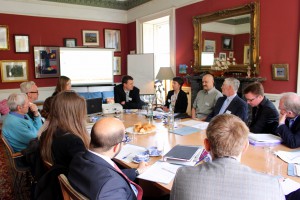
NATO has had its hands full. Drafting and now implementing a new Strategic Concept, responding to the “Arab Spring” and the ongoing war in Afghanistan all equate to a major investment in leadership, resources and time.
Each of these issues is important for NATO security; yet they must not obscure the issue of nuclear threat reduction, which remains a vital issue for the United States, NATO, Russia and all of Europe.
The new Strategic Concept adopted at the 2010 Lisbon NATO Summit recognizes the importance of arms control, disarmament and nonproliferation and endorses further reductions in tactical nuclear weapons. Thus, NATO has already made the decision that the nuclear “status quo” is not where NATO wants to be. Indeed, maintaining the status quo around nuclear deployments that – in the words of a former U.S. Vice Chairman of the Joint Chiefs of Staff, do not serve a military function not already addressed by allied strategic and conventional forces – is not “smart,” and it’s not “defense.”
What is needed then at the Chicago NATO summit is a clear strategy for how to change the status quo. Over the past two years, Isabelle Williams – Senior Program Officer at the Nuclear Threat Initiative (NTI) – and I worked with a distinguished group of Europeans and Americans to define a path forward on reducing nuclear risks in Europe. Our report (available at: www.nti.org/natoreport) and its featured essay by former Senator Sam Nunn, the co-chairman of NTI, outlines a strategy for nuclear threat reduction that builds on the Strategic Concept.
At the heart of that strategy is Senator Nunn’s proposed “10 for 2012” – that is, 10 recommendations to be adopted at the May NATO summit in Chicago. Core elements of “10 for 2012” include:
- A commitment to deepening consultations with Russia on a broad range of Euro-Atlantic security issues – including tactical nuclear weapons, conventional forces and missile defense – centered on the concept of increasing warning and decision time.
- In the context of seeking mutual reductions of tactical nuclear weapons with Russia beginning with enhanced transparency and security, NATO would announce a target for completing consolidation of U.S. tactical nuclear weapons back to the United States within five years – with the final timing and pace determined by broad political and security developments with Russia, including but not limited to their tactical nuclear deployments near NATO’s border. This is meant to be a flexible formula for reciprocity, not a rigid linkage that would preclude progress.
- NATO would also state a declaratory policy: that the fundamental purpose of its nuclear weapons is to deter the use of nuclear weapons by others.
Together, these recommendations are designed to provide a responsible framework for change, one that gives NATO time to work on the core issues of nuclear sharing and reassurance that are also underscored in “10 for 2012.” Importantly, NATO will remain a nuclear alliance for as long as nuclear weapons exist; and extended nuclear deterrence will continue, but in a form that is safer and more credible.
At the same time, the adoption by NATO of “10 for 2012” will also give a greater sense of direction and pace to achieving the goals laid out in the Strategic Concept, including further reductions in tactical nuclear weapons. While “10 for 2012” is not an arms control centered approach, it could be implemented in ways that inform new negotiations and strengthen the next arms control agreement.
Over the past four months, we have been briefing NATO embassies, delegations and officials on the conclusions from our NATO study. The argument that we need a strategy like the Senator’s “10 for 2012” to follow up the Strategic Concept is resonating. Many officials are also of the view that there is still time for an initiative on tactical nuclear weapons and the Deterrence and Defense Posture Review (DDPR) for the Chicago summit in May – and it is now clear that senior levels in a number of NATO capitals are now engaging on this important issue.
We have also heard that much will depend on whether the United States and other key allies lead on the issue all the way to Chicago. These issues may have to be dealt with in the weeks following French elections and before Chicago. Fortunately, resolving these issues within a narrow window should be possible, given they have been extensively discussed for two years in the run up to Lisbon and almost two years after.
One thing should be clear to all NATO members: avoiding this issue for the next few years – even just until the next NATO summit – is more likely to undermine rather then strengthen NATO unity and security. Moreover, as many NATO representatives agree, the status quo presents unacceptable financial and political costs – and inherent security risks – in particular in an era of tight budgets and competing defense priorities. If NATO were to adopt a wait and see attitude on this issue at Chicago, NATO’s options are likely to shrink, not expand.
Instead, NATO should take advantage of the opportunity provided by the DDPR and the Chicago Summit and put in place a strategy – in our view, “10 for 2012.” In doing so, NATO can provide a greater incentive for Russia to engage and increase the chances of seeing cooperation and positive movement from Russia on tactical nuclear weapons, where the dialogue has been frozen for years. As former U.S. Secretary of State George Shultz wrote commenting on our NATO study, “We need to jack up our resolve, use our best brains and creativity, and get moving on this problem now.”
The opinions articulated above represent the views of the author(s), and do not necessarily reflect the position of the European Leadership Network or any of its members. The ELN’s aim is to encourage debates that will help develop Europe’s capacity to address the pressing foreign, defence, and security challenges of our time.
Click here for previous ELN Chicago Forum Papers.



